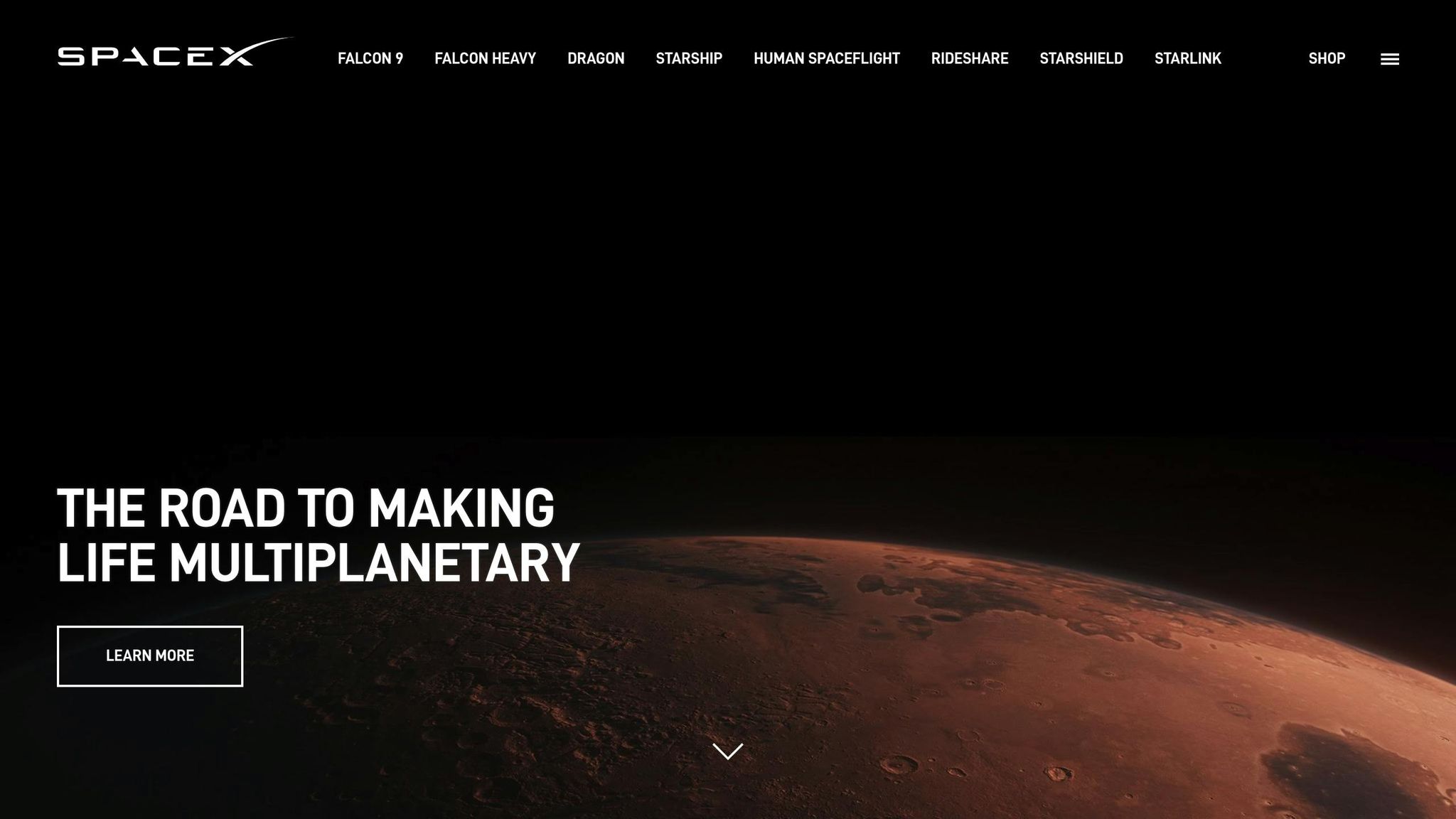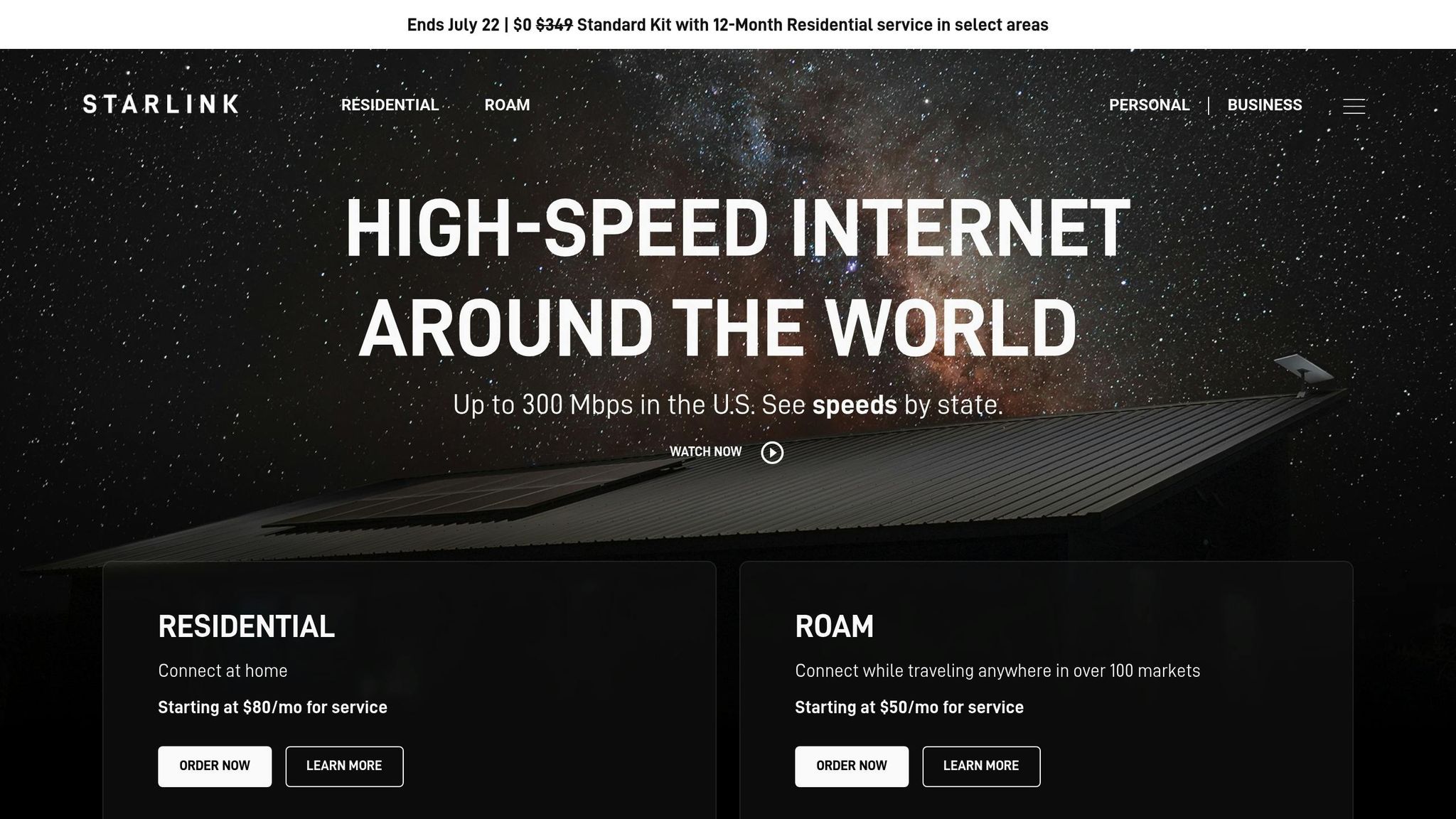5 Metrics to Watch in SpaceX Earnings Reports
Explore the five key metrics driving SpaceX's growth and IPO readiness, from revenue growth to cash reserves and Starlink expansion.

SpaceX is making waves in the aerospace industry, with its valuation now reaching $400 billion as of mid-2025. The company's financial performance is underpinned by five key metrics that highlight its growth and potential IPO readiness:
- Revenue Growth: SpaceX's revenue surged 63% from $8.7B in 2023 to $14.2B in 2024, driven by Starlink (58% of total revenue) and launch services. Projections for 2025 estimate $15.5B-$18.2B in revenue.
- Profit Margins: Operating income reached $4.5B in 2024, with a 35% adjusted profit margin. Reusable rocket technology and vertical integration are key cost-saving factors.
- Starlink Subscriber Growth: Over 6M global users by mid-2025, with ARPU varying by region. Revenue is expected to hit $11.8B in 2025 from 7.8M users.
- Launch Cadence: SpaceX completed 138 launches in 2024 and 89 by mid-2025, aiming for 175-180 this year. Falcon 9's low cost per kilogram ($2,720) solidifies its market dominance.
- Cash Reserves & Spending: With $3B in cash reserves, SpaceX continues to invest heavily in Starship and Starlink, ensuring long-term growth.
These metrics underscore SpaceX's financial health and operational efficiency, making it a prime candidate for public listing. For more details, visit the SpaceX Stock Investment Guide.
Inside SpaceX's Revenue, with Jack Kuhr (Research Director, Payload)

1. Revenue Growth and Business Segments
SpaceX's financial performance has been nothing short of impressive, with revenue skyrocketing from $8.7 billion in 2023 to $14.2 billion in 2024 - a staggering 63% increase. This growth cements SpaceX's position as one of the fastest-growing companies in the aerospace sector. Let’s break down the key drivers behind this surge.
The standout contributor is Starlink, which generated $7.7 billion in 2024, accounting for 58% of SpaceX's total revenue. This marks an extraordinary 83% year-over-year growth for the satellite internet service.
Launch services also played a significant role, with revenue climbing from $3.5 billion in 2023 to $4.2 billion in 2024 - a 19% increase. Government contracts were a major factor here, as SpaceX completed 17 government launches in 2024 compared to just 9 the previous year. A prime example is NASA's $620 million lunar lander deal, underscoring the strategic importance of these partnerships.
In addition to these core segments, SpaceX's diversification efforts are starting to pay off. Other revenue streams, including satellite manufacturing and specialized services, contributed $720 million in 2024.
| Business Segment | 2023 Revenue | 2024 Revenue | Growth Rate |
|---|---|---|---|
| Starlink | $4.2B | $7.7B | 83% |
| Launch Services | $3.5B | $4.2B | 19% |
| Other Revenue | - | $720M | - |
| Total | $8.7B | $14.2B | 63% |
Looking ahead, projections for 2025 estimate revenue between $15.5 billion and $18.2 billion. These forecasts reflect growing optimism about Starlink's subscriber base and the expanding commercial space market.
Notably, the shift from one-off launch contracts to recurring Starlink subscriptions has boosted profitability. In Q1 2023, SpaceX reported a $55 million profit on $1.5 billion in revenue.
For investors, keeping an eye on the performance of these revenue segments offers a valuable window into SpaceX's potential for sustained growth in an increasingly competitive space economy.
2. Profit Margins and Operating Efficiency
SpaceX's profit margins provide a clear picture of how effectively the company turns revenue into profit. These numbers not only reflect its ability to manage costs but also highlight its competitive strength in the space industry.
In 2023, SpaceX achieved an impressive 35% adjusted profit margin. To put that into perspective, Lockheed Martin's space division reported an operating profit margin of less than 9% during the same period. This stark difference emphasizes SpaceX's operational efficiency and ability to control expenses.
By 2024, SpaceX's operating income climbed to $4.5 billion. One analysis attributed this success to the company's pricing strategy:
"For now, SpaceX has the luxury of setting prices based on the next-best alternative versus its own operational costs - a model which allows SpaceX healthy profit margins." - Sacra
Starlink, SpaceX's satellite internet service, also contributed to its financial performance. In 2024, Starlink posted $72.7 million in net profit with a 7% gross margin. While this margin is lower than Viasat's 33% and Echostar's 25.9%, there's potential for improvement as subscriber numbers grow.
SpaceX's vertical integration strategy plays a key role in boosting margins. For example, the company manufactures onboard radios for $5,000 - a massive reduction compared to the industry standard of $100,000. Add to that the game-changing impact of its reusable rocket technology, which has slashed satellite launch costs from $400 million to $62 million, achieving 5–10× lower costs per ton compared to competitors.
Operational milestones also underline SpaceX's efficiency. The Falcon 9 recently completed its 500th orbital mission, maintaining a flawless 100% launch success rate. This reliability further supports the company's drive for better margins.
SpaceX's business model is self-reinforcing: revenue from launches funds research and development, which reduces costs and opens new revenue streams like Starlink. This cycle suggests profit margins could continue to grow, complementing the company's rising revenue and paving the way for deeper operational insights.
For a closer look at SpaceX's financial trends, visit the SpaceX Stock Investment Guide.
3. Starlink User Growth and Revenue Per Customer

Starlink's subscriber growth highlights SpaceX's expansion beyond its core focus on rocket launches. By July 2025, the satellite internet service had amassed over 6 million customers worldwide, including more than 2 million active users in the United States alone. This marks a significant leap, with SpaceX adding over 600,000 U.S. customers in just about a year.
Looking at regional trends, North America accounts for the lion’s share - around 47% of Starlink users. Europe follows with 12%, Asia 14%, Latin America 17%, and both Africa and Oceania at 6% each as of Q1 2025. However, the most striking growth is happening in emerging markets, where adoption is picking up pace.
Revenue per customer varies widely depending on the region, posing both opportunities and hurdles for SpaceX's financial performance. For instance, U.S. customers typically pay $120 per month for standard service. But international pricing aligns with local economic conditions: in France, users pay about $41 monthly, while Brazilian customers pay $30, and Zambian subscribers just $24. This pricing approach explains why revenue growth hasn't kept pace with subscriber additions, especially as Starlink expands into markets with lower average incomes.
In 2024, Starlink generated $8.18 billion in revenue, and Quilty Space projects sales to reach $11.8 billion in 2025, with an estimated 7.8 million customers. The average revenue per user (ARPU) for residential customers stands at around $85 per month, reflecting the service's expansion into price-sensitive regions.
To drive adoption, SpaceX has rolled out strategic pricing models. The "Residential Lite" plan, priced at $80 per month, and promotions offering free Starlink dishes with a one-year commitment have contributed to increased U.S. adoption. Satellite industry analyst Tim Farrar commented:
"The US growth presumably reflects the low-priced Lite package and free terminals with a year's commitment".
SpaceX's long-term goals are ambitious. The company reportedly aims to reach 20+ million subscribers by 2030, a target that requires a considerable acceleration from current levels. With Starlink now available in 114 countries and territories, covering about 2.67 billion people by Q1 2025, the potential market remains enormous.
However, growth patterns vary significantly by region. For example, Canada, nearing market saturation, added just 100,000 subscribers over the past year, bringing its total to over 500,000. In contrast, developing markets like Kenya and Rwanda are seeing slower adoption rates. This regional disparity underscores the challenge of balancing rapid subscriber growth with maintaining high ARPU in international markets.
For those keeping an eye on Starlink's performance, the main takeaway is this: while adding millions of users builds scale, the shift toward lower-revenue markets impacts short-term profitability. Understanding this balance is key to evaluating Starlink's role in SpaceX's broader financial strategy. Up next, we’ll explore how launch frequency and contract backlogs further highlight SpaceX's growth trajectory.
4. Launch Frequency and Contract Backlog
SpaceX's launch pace is a clear reflection of its efficiency and ability to generate revenue. In 2024, the company completed 138 missions, solidifying its dominance in the U.S. launch market. By mid-2025, specifically by July 16, SpaceX had already achieved 89 rocket launches - this included 87 Falcon 9 missions, no Falcon Heavy flights, and two Starship tests. That’s an incredible average of one launch every 2.26 days. This high frequency not only highlights operational efficiency but also sets the stage for future revenue growth.
Looking ahead, SpaceX has set an ambitious goal for 2025: 175 to 180 Falcon 9 launches. With 47 launches already completed by May 2025, the company seems on track to meet or even surpass this target. A key factor in maintaining this rapid cadence is the 98% reusability rate of Falcon 9 boosters, which significantly lowers costs.
When it comes to cost efficiency, SpaceX is in a league of its own. The Falcon 9 operates at just $2,720 per kilogram to orbit, compared to traditional providers like Boeing and Lockheed Martin, who charge anywhere from $10,000 to $25,000 per kilogram. This pricing advantage has allowed SpaceX to dominate the market. For instance, the company was responsible for 98 of 109 total U.S. launches in 2023 and 138 out of 145 U.S. launches in 2024. Beyond this, SpaceX has a backlog of 140 planned flights through 2031. However, demand has outstripped the company’s capacity, creating a backlog that requires careful management to meet its contractual obligations.
A significant portion of this backlog comes from government contracts. In October 2024, the U.S. Space Force awarded SpaceX two National Security Space Launch (NSSL) Phase 3 Lane 1 task orders worth over $733.5 million. These contracts cover nine launches scheduled for late 2025 and 2026. Under the broader NSSL Phase 3 program, SpaceX is set to handle 28 missions, representing about 60% of launches contracted from fiscal year 2025 to 2029, with an estimated value of $5.9 billion.
Brig. Gen. Kristin Panzenhagen, program executive officer for Assured Access to Space, stressed the importance of quick deployment in today’s geopolitical landscape:
"In this era of great power competition, it is imperative to not leave capability on the ground... The Phase 3 Lane 1 construct allows us to execute launch services more quickly for the more risk-tolerant payloads, putting more capabilities on orbit faster in order to support national security".
SpaceX’s launch rate has grown 1.5x over the past three years, showcasing its ability to scale operations. In 2024, its launch frequency was more than double that of its closest competitors combined, reaffirming its position as the world’s leading space launch provider. This operational edge continues to drive consistent contract wins and steady revenue streams.
These performance metrics underscore SpaceX's operational capabilities and set the groundwork for evaluating its financial reserves and investment strategies.
5. Cash Reserves and Capital Spending
SpaceX's financial health is reflected in its impressive cash reserves, which enable the company to take on massive projects like the development of Starship. As of July 2025, SpaceX held over $3 billion in cash, providing a strong foundation for its ambitious plans. This financial cushion allows the company to confidently push forward with its high-stakes initiatives.
In July 2025, SpaceX allocated $2 billion to Elon Musk's xAI, demonstrating its strategic approach to capital allocation. Musk has consistently used SpaceX's resources to further his broader business goals, showcasing the company's role as a key player in his overarching vision.
Since its inception in 2002, SpaceX has averaged $1 billion in annual cash burn. However, spending has surged since 2016/17 due to significant investments in Starlink and Starship. These initiatives demand substantial funding to hit operational milestones and maintain a competitive edge in the space industry.
SpaceX's robust cash reserves allow it to pursue aggressive spending strategies. While this approach leads to negative cash flow, it’s a calculated move aimed at fueling rapid growth. The company’s ability to balance operational cash flow with its reserves ensures it can sustain this high level of investment while chasing market leadership.
The company’s rising valuation underscores its capital-intensive strategy. By July 2025, SpaceX's valuation had climbed to $400 billion, up from $350 billion in December 2024. Since its founding, SpaceX has raised approximately $12 billion in primary funding, highlighting its ability to attract capital from investors.
SpaceX's current spending priorities focus on two major projects: Starlink and Starship. Starlink is projected to bring in $12.3 billion from 7.6 million subscribers in 2025, creating a growing revenue stream to fund further investments. Meanwhile, NASA contracts, including nearly $15 billion tied to Artemis lunar missions, provide additional financial stability.
Profitability remains a key focus. According to Euroconsult, SpaceX may barely break even with 6–8 launches per year, but gross profit margins could soar to 40–50% with 20 launches annually. Broader market trends also work in SpaceX's favor, with Space Capital reporting a $26 billion investment in space companies in 2024 - a 30% increase from the previous year.
Looking ahead, ARK Investment Management predicts that SpaceX's enterprise value could reach $2.5 trillion by 2030. This suggests that today’s investments may lead to significant returns down the line. With its current cash reserves and reinvestment strategy, SpaceX seems well-prepared to continue its upward trajectory while meeting its capital demands.
Conclusion
SpaceX's financial foundation is solid, driven by rising revenues, diverse income streams, and strong profit margins. The rapid growth of Starlink, which saw its subscriber base jump from 2.7 million to nearly 5 million across 114 countries in just one year - a 100% increase - illustrates the impressive expansion of its satellite internet services.
The company's operational strength is further highlighted by its launch cadence and contract backlog. With an estimated 130 launches planned for 2024, SpaceX is on track to handle more than half of all global rocket launches. Combined with robust cash reserves and significant capital investments, these factors showcase SpaceX's ability to innovate and scale.
Each element of SpaceX's strategy connects seamlessly: the growth in Starlink subscribers boosts ARPU (average revenue per user) and margins, while increased launch frequency drives down costs. Meanwhile, healthy cash reserves support ongoing investments in groundbreaking projects like Starship. This integrated approach positions SpaceX as a strong contender for a pre-IPO status. SpaceX President and COO Gwynne Shotwell emphasizes the transformative potential of Starship:
"Ultimately, I think Starship will be the thing that takes us over the top as one of the most valuable companies. We can't even envision what Starship is going to do to humanity and humans' lives, and I think that will be the most valuable part of SpaceX."
For those looking at pre-IPO investment opportunities, understanding these key metrics is crucial, especially given the limited financial transparency of private companies. With the space economy projected to hit $1.8 trillion by 2035, SpaceX's current $350 billion valuation would place it among the top 25 companies in the S&P 500 if it were publicly listed.
Aspiring investors can explore platforms like the SpaceX Stock Investment Guide to gain deeper insights. This resource provides information on SpaceX's funding rounds, stock price trends, and private equity market dynamics. Through its free Investor Club, it connects individuals interested in the growing space sector.
With over $120 billion in private stock expected to change hands in 2025, these factors collectively underline SpaceX's trajectory and offer valuable guidance for strategic pre-IPO investment decisions.
FAQs
How does SpaceX's reusable rocket technology impact its profitability and market leadership?
SpaceX's approach to reusable rockets has completely reshaped the financial landscape of space launches, slashing costs by as much as 65%. This dramatic reduction doesn't just improve profit margins - it also enables SpaceX to offer more competitive pricing, drawing in a larger client base.
Thanks to this game-changing reuse strategy, SpaceX now commands over 60% of the global commercial launch market. This achievement not only reinforces the company's profitability but also cements its dominance in the industry. By cutting costs and expanding its market share, SpaceX continues to lead the way in the ever-evolving space sector.
What are the main challenges and opportunities for Starlink's expansion in global markets?
Starlink encounters a range of challenges as it works to expand its global footprint. One major issue is dealing with regulatory barriers, such as non-tariff trade restrictions, which can drive up costs and slow down the rollout of services in certain regions. On top of that, concerns about space debris and the growing risk of orbital congestion create both environmental and legal complications for its operations.
That said, there’s plenty of room for growth. Starlink has a unique opportunity to target rural and remote areas where reliable internet access is scarce. Its scalable technology and global coverage plan have already allowed it to reach over 100 countries and gain millions of subscribers. By forming strategic partnerships and pushing forward with new advancements, Starlink is well-positioned to strengthen its presence in international markets.
How is SpaceX's financial strategy preparing it for a potential IPO?
SpaceX is gearing up for a potential IPO, with its valuation estimated at an impressive $400 billion. To strengthen its financial position, the company has been raising funds through secondary share sales and fresh capital injections, building up significant cash reserves.
This financial strategy serves a dual purpose: it fuels SpaceX's ambitious growth initiatives while also boosting investor confidence. With ample liquidity and a strong valuation, the company is setting the stage to draw substantial interest when it eventually decides to enter the public market.
Comments ()